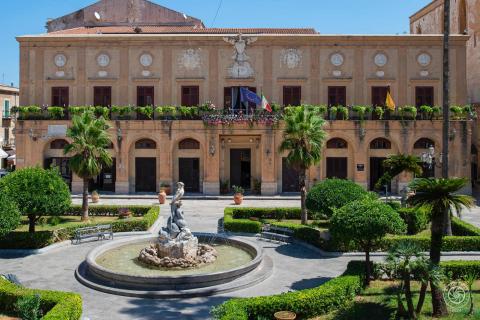Monreale has been considered an archiepiscopal city since ancient times. It was founded as a village formed by neighbourhoods attached to the majestic monastery complex built in 1172 at the behest of the Norman King Guglielmo II of the Sicilian Altavilla dynasty. Guglielmo had been born in December 1153, becoming king at only 13 years of age. In 1166 he took the throne and, perhaps also to emulate his very famous ancestor Ruggero II, creator of the Kingdom of Sicily, decided to commission the grandiose project for the construction of a Benedictine Abbey with a spectacular Cloister, but above all a splendid Basilica to be dedicated to the Virgin Mary. Legend has it that the Virgin, who came to him in a dream, had ordered him to do so. The Abbey was built on a wooded plateau of Monte Caputo, four miles from Palermo, inside a royal park full of wild animals that the Norman kings had always used for their hunting parties. For this reason, the abbey complex took the name Montis Regalis , i.e., Mount of the King , and today it still retains the title of Monreale , whose coat of arms consists of a starred shield on a light blue background surmounted by a golden royal crown. At that time, the plateau was part of a Saracen farmstead, an agricultural district consisting of land and houses, the Bulchar farmstead. It was located inside the park where the Saracens who remained in Sicily after the Norman conquest of the island lived as villagers and peasants. Before the new conquerors, the island had been inhabited for 250 years by Muslims from the African Maghreb and it had become the Emirate of Sicily between the years 948 and 1091 under the name Imārat Siqilliyya. The rest of the territory of Bulchar and other Saracen peasant farmsteads stretched as far as the mountains that crown the hilly part of the plain surrounding Palermo called the Conca d'Oro, which can be splendidly admired from here as far as the Tyrrhenian Sea. The many Saracen populations stretched beyond the mountains towards the valleys of the Jato and Belìce rivers. The Abbey was also a Christian bulwark against the Muslim populations that had settled in this territory. The young king, profoundly religious and convinced of the mission assigned by the Pope of Rome to the Kings of Sicily as his representatives in the territories of the Kingdom, continued pursuing the Latin Christianisation of the island, which would be completed after him by his nephew King Federico of Sicily, known as the Stupor Mundi. The abbey complex was built as a fortified citadel in an enclosure surrounded by twelve towers some of which, after more than eight centuries, still flaunt their medieval beauty. Guglielmo entrusted the Latin Christianisation of the territory to 100 Benedictine monks, at that time the most important monastic order of the Middle Ages, custodians of the cultural tradition of the Western Latin Rite Church. The monks built an autonomous monastery whose abbot was only answerable to the king in person and to whom land, castles, towns, farmsteads, animals, churches and monasteries were assigned as a royal donation, the tithes of which would constitute the necessary sustenance for the monks and for the complex as a whole. In 1182, Pope Lucio III confirmed the king's wishes and elected the abbey as an archiepiscopal see. The Archbishop thus became the recognised and undisputed Lord of an autonomous and vast territory spanning 1,200 square kilometres. Thus the State of Monreale was born, which maintained its autonomy until the Unification of Italy in 1861.
Credits: Arch. Paola La Scala
